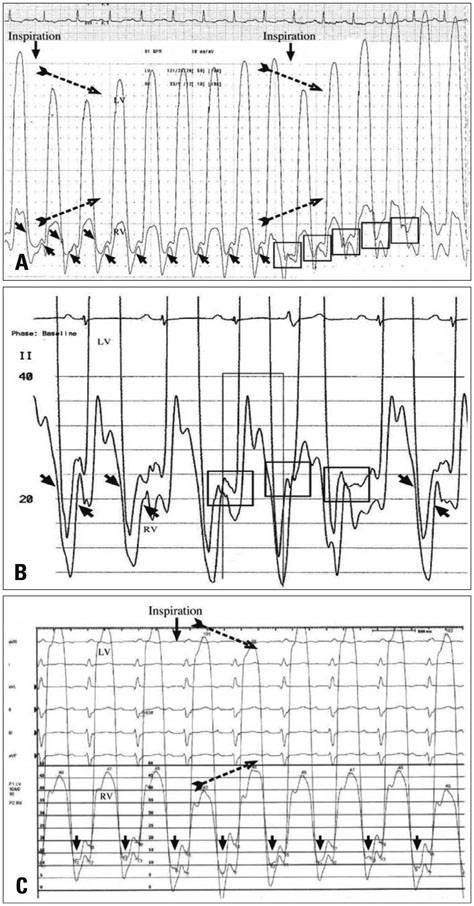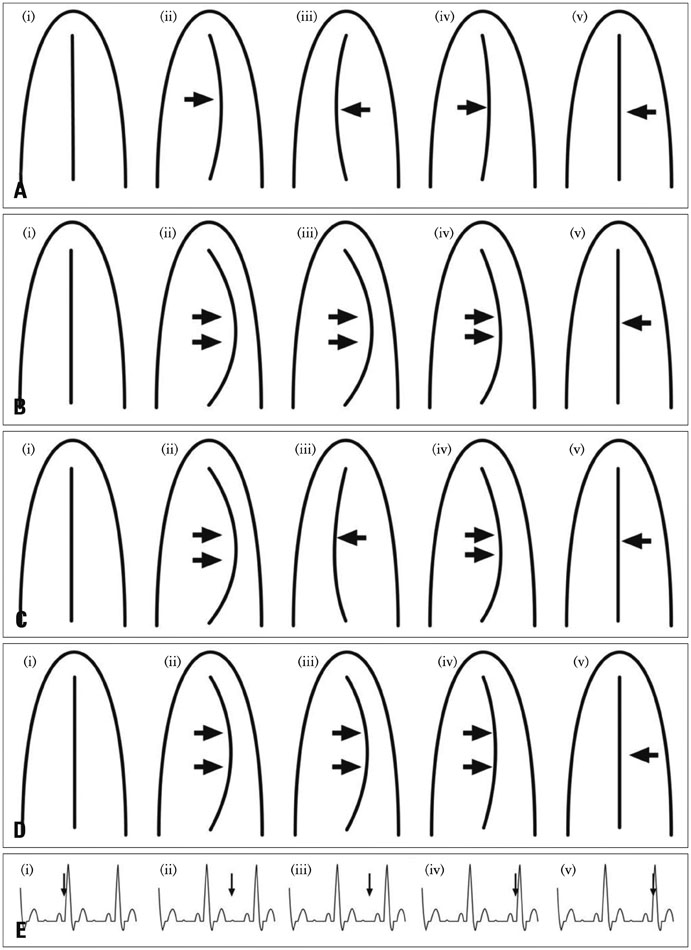J Cardiovasc Ultrasound.
2015 Sep;23(3):143-149. 10.4250/jcu.2015.23.3.143.
A Potential Echocardiographic Classification for Constrictive Pericarditis Based on Analysis of Abnormal Septal Motion
- Affiliations
-
- 1Department of Cardiology, Waikato Hospital, Hamilton, New Zealand. dilesh@heartcarecentre.co.nz
- 2Department of Cardiology, Khoo Teck Puat Hospital, Singapore.
- 3Department of Cardiothoracic Surgery, Waikato Hospital, Hamilton, New Zealand.
- 4Department of Cardiology, Royal Prince Alfred Hospital, Sydney, Australia.
- KMID: 2068724
- DOI: http://doi.org/10.4250/jcu.2015.23.3.143
Abstract
- BACKGROUND
Constrictive pericarditis is an uncommon condition that could be easily confused with congestive heart failure. In symptomatic patients, septal "wobble" on echocardiography may be an important sign of constrictive physiology. This study was planned to investigate the effects of constriction on septal motion as identified by echocardiography.
METHODS
In this retrospective observational study, nine consecutive patients with constriction underwent careful echocardiographic analysis of the interventricular septum (IVS) with slow motion 2-dimensional echocardiography and inspiratory manoeuvres. Six patients who had undergone cardiac magnetic resonance imaging underwent similar analysis. Findings were correlated with haemodynamic data in five patients who had undergone cardiac catheterisation studies.
RESULTS
In mild cases of constriction a single wobble of the IVS was seen during normal respiration. In more moderate cases a double motion of the septum (termed "double wobble") was seen where the septum bowed initially into the left ventricle (LV) cavity in diastole then relaxed to the middle only to deviate again into the LV cavity late in diastole after atrial contraction. In severe cases, the septum bowed into the LV cavity for the full duration of diastole (pan-diastolic motion). We describe how inspiration also helped to characterize the severity of constriction especially in mild to moderate cases.
CONCLUSION
Echocardiography appears a simple tool to help diagnose constriction and grade its severity. Larger studies are needed to confirm whether the type of wobble motions helps to grade the severity of constrictive pericarditis.
Keyword
MeSH Terms
Figure
Reference
-
1. Candell-Riera J, García del Castillo H, Permanyer-Miralda G, Soler-Soler J. Echocardiographic features of the interventricular septum in chronic constrictive pericarditis. Circulation. 1978; 57:1154–1158.
Article2. Hatle LK, Appleton CP, Popp RL. Differentiation of constrictive pericarditis and restrictive cardiomyopathy by Doppler echocardiography. Circulation. 1989; 79:357–370.
Article3. Himelman RB, Lee E, Schiller NB. Septal bounce, vena cava plethora, and pericardial adhesion: informative two-dimensional echocardiographic signs in the diagnosis of pericardial constriction. J Am Soc Echocardiogr. 1988; 1:333–340.
Article4. Hurrell DG, Nishimura RA, Higano ST, Appleton CP, Danielson GK, Holmes DR Jr, Tajik AJ. Value of dynamic respiratory changes in left and right ventricular pressures for the diagnosis of constrictive pericarditis. Circulation. 1996; 93:2007–2013.
Article5. Talreja DR, Nishimura RA, Oh JK, Holmes DR. Constrictive pericarditis in the modern era: novel criteria for diagnosis in the cardiac catheterization laboratory. J Am Coll Cardiol. 2008; 51:315–319.
Article6. Feneley M, Gavaghan T. Paradoxical and pseudoparadoxical interventricular septal motion in patients with right ventricular volume overload. Circulation. 1986; 74:230–238.
Article7. Giorgi B, Mollet NR, Dymarkowski S, Rademakers FE, Bogaert J. Clinically suspected constrictive pericarditis: MR imaging assessment of ventricular septal motion and configuration in patients and healthy subjects. Radiology. 2003; 228:417–424.
Article8. Francone M, Dymarkowski S, Kalantzi M, Bogaert J. Real-time cine MRI of ventricular septal motion: a novel approach to assess ventricular coupling. J Magn Reson Imaging. 2005; 21:305–309.
Article9. Francone M, Dymarkowski S, Kalantzi M, Rademakers FE, Bogaert J. Assessment of ventricular coupling with real-time cine MRI and its value to differentiate constrictive pericarditis from restrictive cardiomyopathy. Eur Radiol. 2006; 16:944–951.
Article
- Full Text Links
- Actions
-
Cited
- CITED
-
- Close
- Share
- Similar articles
-
- The Clinical Course of Tuberculous Pericarditis in Immunocompetent Hosts Based on Serial Echocardiography
- Echocardiographic Evaluation of Constrictive Pericarditis
- Constrictive Pericarditis Following Acute Idiopathic Pericarditis
- Pericardiectomy by a Left Limited Anterolateral Thoracotomy for Constrictive Pericarditis after Cardiac Surgery: 2 case reports
- The Cardiac MR Images and Causes of Paradoxical Septal Motion




